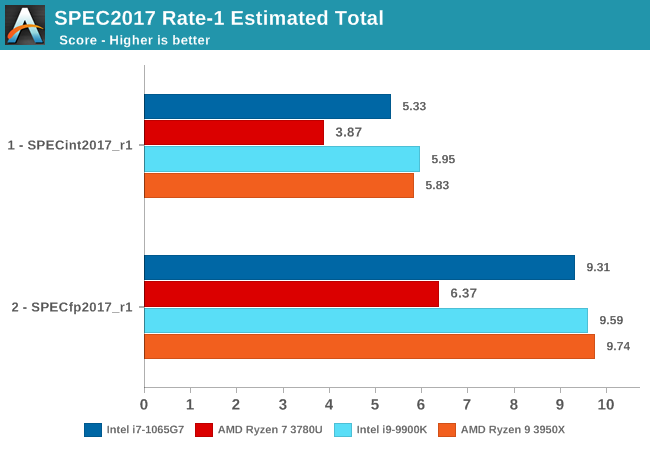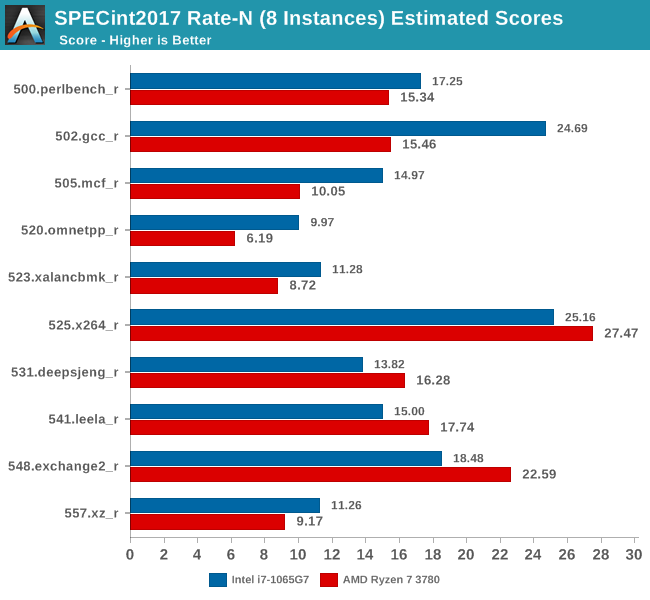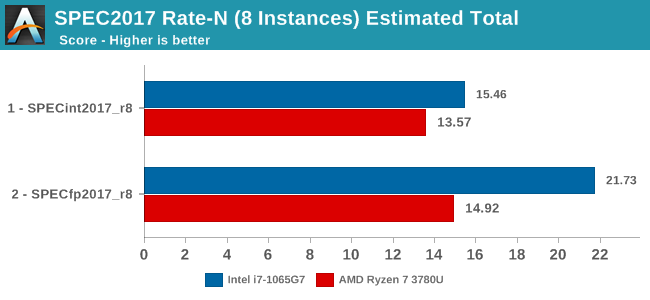The Microsoft Surface Laptop 3 Showdown: AMD's Ryzen Picasso vs. Intel's Ice Lake
by Brett Howse & Andrei Frumusanu on December 13, 2019 8:30 AM ESTSection by Andrei Frumusanu
SPEC2017 - ST & MT Performance
Starting off with SPEC, we’re trying to analyze the AMD and Intel systems in direct comparison to each other in a wide variety of workloads. In general, we shouldn’t be expecting too big surprises in the results as earlier this summer we had the opportunity to cover Intel’s Ice Lake CPUs, and the Surface Laptop 3 implementation of the Core i7-1065G7 should pretty much fall in line with those scores.
On AMD’s side, we hadn’t tested the company’s mobile processors in SPEC so this should represent a good opportunity to showcase the two companies’ products side-by-side. As a reminder, the Ryzen 7 3870U tested today is based on AMD’s Picasso chip, a 12nm implementation of the Zen+ microarchitecture, which isn’t quite as up-to-date as the 7nm Zen2 silicon that the company offers in its desktop Ryzen 3000 chips. In a sense, while both products tested today represent the companies’ best mobile products, for Intel it also represents the company’s best technologies, and thus the ICL part has a generational advantage over AMD's current product-line.
We’re limiting our testing this time around to SPEC2017 as it represents the more modern workload characterisations, and we’ve already covered the microarchitectural giveaways presented by SPEC2006 in past articles. We’re testing under WSL1 in Windows due to simplicity of compilation and compatibility, and are compiling the suite under LLVM compilers. The choice of LLVM is related to being able to have similar code generation across architectures and platforms. Our compiler versions and settings are as follows:
clang version 8.0.0-svn350067-1~exp1+0~20181226174230.701~1.gbp6019f2 (trunk) clang version 7.0.1 (ssh://git@github.com/flang-compiler/flang-driver.git 24bd54da5c41af04838bbe7b68f830840d47fc03) -Ofast -fomit-frame-pointer -march=x86-64 -mtune=core-avx2 -mfma -mavx -mavx2
Our compiler flags are straightforward, with basic –Ofast and relevant ISA switches to allow for AVX2 instructions.
Single-Threaded Performance: Intel Dominance
Starting off with single-threaded tests, we’re having a closer look at the integer SPEC20017 suite results.
We’re also adding in AMD and Intel’s top-performing desktop chips into the mix to better convey a context as to where these mobile parts fall in terms of absolute performance, which I think is a major consideration point for the Surface Laptop 3, particularly the Ice Lake models.

The first thing that comes to mind when looking at these results is that there’s a huge discrepancy between what the Intel and AMD models of the Surface Laptop 3. It’s very evident that Intel’s new Ice Lake CPUs and the Sunny Cove microarchitecture have quite a large lead over the Zen+ based Picasso SoC.
The Intel model's performance is near identical to what we’ve measured back in August on Intel’s development platform: we again see the chip being able to keep up with even Intel’s best performing desktop solutions which are running at far higher frequencies and larger power draw.
The Ryzen 7 3780U isn’t quite able to showcase a similar positioning, as it’s notably further behind the Ryzen 9 3950X with the newer Zen2 microarchitecture and faster memory configuration.

The situation in the floating-point suite is very similar, with the Core i7-1065G7 taking a quite considerable lead over the Ryzen 7 3780U. The 519.lbm results here are interesting due to the fact that AMD’s platform is behind by a factor greater than 2x – the test is memory bandwidth and subsystem limited so it’s possibly a bigger bottleneck on the slower DDR4-2400 memory that the system has to make due with. Intel’s LPDDR4X-3733 is able to well keep up with the desktop platforms in such situations.
But even in less memory intensive workloads such as 511.povray, AMD’s IPC disadvantage is too great and even with a theoretical higher peak frequency of 500MHz, the Zen+ based design is too far behind Intel’s new microarchitecture.

The overall SPEC2017 ST scores are pretty one-sided, with the Intel variant of the Surface Laptop 3 being ahead by 37% in the integer suite, and 46% in the floating-point suite. We hadn’t really expected the AMD system to be able to keep up with the Intel CPU, but these results really just expose the technological differences between the two designs. AMD’s Zen2 and LPDDR4X APUs can’t come early enough, as this is a gap that the company needs to close as soon as possible if it wants to compete in high-end laptop designs.
Multi-Threaded Performance: Continued Intel Advantage
While it’s clear that Intel has a large single-threaded performance advantage, we wanted to also see the competitive situation in a multi-threaded/multi-process comparison between the two chips. In the Rate-N test configuration of SPEC, we’re launching 8 instances on both platforms to fully saturate the system and have two processes per physical CPU.
In the MT tests, the AMD system ran at frequencies between 2.9-3.35GHz, whilst the Intel platform ran between 2.6-3.5GHz, depending on workload. TDP, or better said, peak power consumption, plays a bigger role in these tests as the 4-6 hours runtime of the test means we’re really stressing the cooling solutions of the laptops. Intel’s chip here is allowed to draw up to 44W for short durations before it falls down to a sustained 25W. We weren’t able to accurately measure the power draw for the AMD platform but we do note that it looks like under prolonged stress the CPU was around 10°C colder than the Intel variant, with ~70°C at 2.9GHz for the Ryzen system versus 80°C at 2.6GHz for the Intel system, which could point out to a lower sustained power draw for the AMD system.

In the integer suite, we mostly seeing the Intel system being ahead, but this time around AMD also manages to win a few tests. The tests where AMD fared best were workloads which have a higher execution characterization, compared to more strictly memory-bound tests such as mcf or omnetpp, where Intel has a clear lead in. Intel’s lead in 502.gcc is pretty massive as well as surprising – I hadn’t expected such a gap, but then again, it’s quite in line with what we saw in the ST results.

In the floating-point suite AMD loses the few advantages that it had, and falls further behind the Intel platform. The FP suite is a lot more memory bound, and Picasso’s memory subsystem here just can’t keep up. The 519.lbm and 554.roms results are particularly shocking as they’re essentially almost no faster than the single-threaded results – the system here is utterly bottlenecked and can’t even scale up in performance over multiple cores.

The overall results for the Rate-8 tests across all physical and logical cores of both the Ice Lake and Picasso systems see a similar performance discrepancy as showcased in the ST results: The Intel Core i7-1065G7 is ahead by 13.9% in the integer suite and a massive 45.6% in the FP suite. The one bottleneck that’s seemingly holding back the AMD system the most is its memory subsystem, and workloads which particularly stress this part of the CPU microarchitectures are the tests in which the Ryzen system fared by far the worst.
All in all, Intel’s process node, microarchitectural IPC, and memory technology lead in the Ice Lake solution is seemingly just too much for the Picasso chip to be able to compete with. Let’s move on to our standard test suite benchmarks and see if the we can correlate similar results in other workloads…










174 Comments
View All Comments
Korguz - Friday, December 20, 2019 - link
HStewart.. and yet to STILL believe the lies intel tells you.. that is why you are thought of as an intel fanboy... until intel delivers on what they claim, and actually have products out, and no, the limited products on 10nm, that max out at quad core and lower frequencies then 14, does NOT count, anything they say, should be treated as BS...going by your post.. you have NO proof of your claims... and they are in fact, just your opinions...
MBarton - Monday, December 30, 2019 - link
At this point Intel's roadmaps are nothing more than lip service for investors. Absolutely nobody takes them seriously.djayjp - Friday, December 13, 2019 - link
AMD should've led Zen 2 (third gen Ryzen) with mobile first. Oh well maybe next generation.djayjp - Friday, December 13, 2019 - link
Also the marketing name for the chips really doesn't help, in fact I think it works against them and makes them look bad.ChubChub - Sunday, December 15, 2019 - link
Absolutely this. A friend's 6600k just died, and wanted to go with AMD. I'm up to date with most computer stuff, so he asked my opinion.He was thinking a 3400g,because APU + 3rd gen Ryzen. It was weird to tell him that AMD stupidly named the 1st gen APUs with the 2nd gen nomenclature … then continued this stupidity for no reason. All chips 1xxx are Zen, all 2xxx chips are Zen+, all 3xxx chips are ZEN 2 … well, except the APUs, which are all back a generation.
I have high hopes for the 4xxx APUs; would be nice if they fixed the naming by pushing them back to 3xxx. However, even better would be Zen 3 cores in mobile; 4xxx naming would then make sense, they could get some volume out on the 7nm+ process that already works, use ASMedia/VIAs new higher efficiency chipset slated for Zen 3, and they'd likely decidedly obliterate Intel's offerings on CPU and GPU performance (probably not on power though; Intel is doing some good stuff there). One can dream.
MikhailT - Friday, December 13, 2019 - link
I disagree, AMD is winning over a lot of the big businesses with their EPYC chips. They need the cash more than they need laptop revenue at the moment and 7nm capacity is very limited. It's best to start with the highest-profit maker first.Get the business on their side, get more money to grow their team and then they'd be able to do more stuff at the same time like Mobile, Server, Desktop, Gaming, and so on.
All this means is that we can hope to look forward to see what Surface Laptop 4 can do with AMD's Zen 2 chips when it comes out next year.
MBarton - Monday, December 30, 2019 - link
Why? So AMD can delay their most valuable products (Epyc and Threadripper) so they can attempt to make some low margin mobile sales? Ridiculous. Mobile is one area that Intel is still fairly competitive in. There's no reason to give up high margin markets where AMD has a strong advantage, for a market where AMD would be forced to compete head on with Intel 10nm for low margin sales.Fataliity - Friday, December 13, 2019 - link
It is interesting how you did the test. I understand ur playing at "Value" because its a laptop. But if its getting 100FPS why couldn't you turn up the graphics a bit to get around 60, to show what people should expect? Because at "Value" you are purposelly making the 18% IPC affect the FPS in the situation (720p is "CPU Bound" at low)...I also noticed you used alot of "real world" names for your cpu tests, even synthetics. While the gpu synthetics you just called "gpu tests"...
... You put the Ice Lake system in the best possible light is what I"m saying. Gave it every advantage. Why?
Lord of the Bored - Saturday, December 14, 2019 - link
Because it is the thirteenth. They are wildly and insanely obviously in the pocket of Intel on odd days. Come back on an even day if you want an AMD-biased test, because those are the days AMD bought.Brett Howse - Saturday, December 14, 2019 - link
Because we use the data for future articles:https://www.anandtech.com/bench/Notebook/725
If I run at random settings then the data isn't useful for the future.
Also if anything the AMD system was put in the best light because it was running at 1280x720 instead of 1366x768, as mentioned in the article.